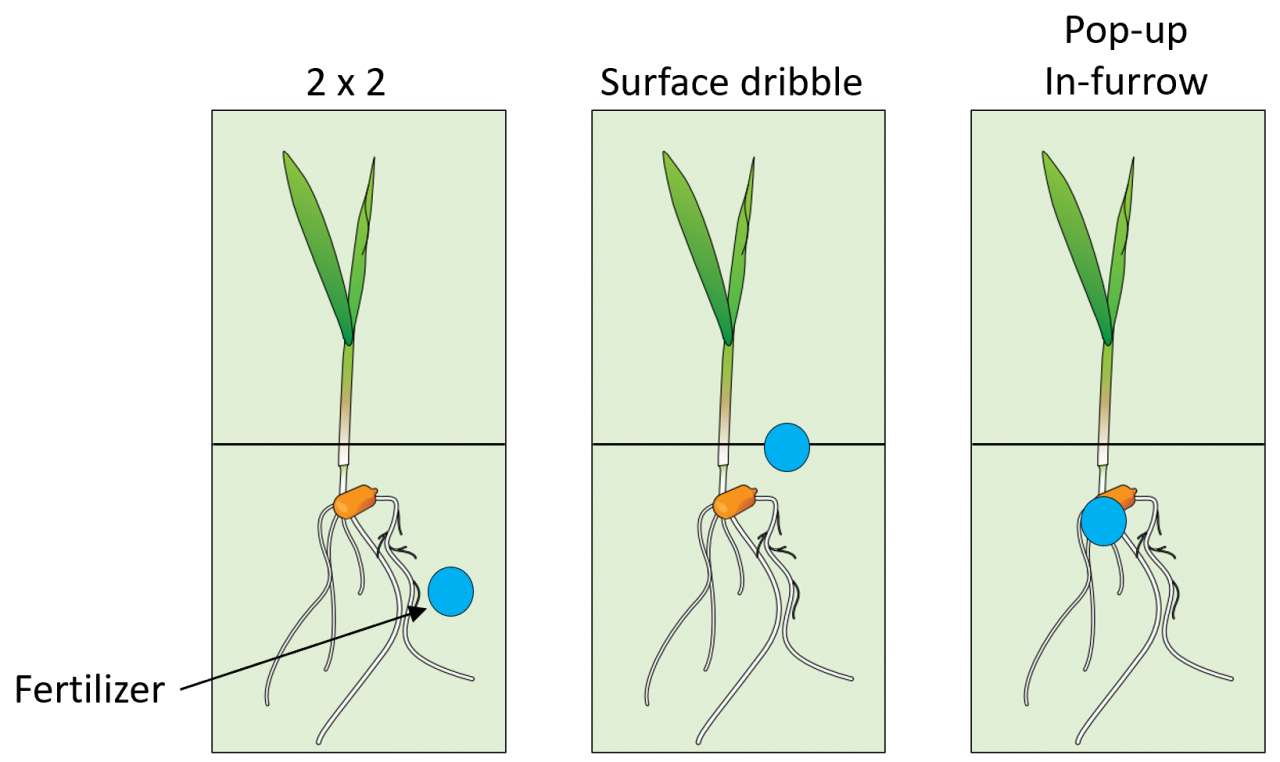Starter fertilizer is typically considered as the placement of a small rate of fertilizer, usually nitrogen (N) and phosphorus (P), near the seed at planting time. This fertilizer is intended to "jump start" growth in the spring, and it is not unusual for a producer to see an early-season growth response to starter fertilizer application. But some producers might also consider using this opportunity to apply higher rates of fertilizer that can supply most of the N and P needs for the corn crop.
Producers should be very cautious about applying starter fertilizer that includes high rates of N (and/or K). It is best to have some soil separation between the starter fertilizer and the seed. The safest placement methods for starter fertilizer are either as a deep-band application 2 to 3 inches to the side and 2 to 3 inches below the soil surface (2x2), or as a surface-band application to the side of the seed row at planting time (2x0), especially in conventional tillage or where farmers are using row cleaners or trash movers in no-till (Figure 1).

Figure 1. Example illustrations of starter fertilizer placement with respect to the corn plant. Graphic by Dorivar Ruiz Diaz, K-State Research and Extension.
What are the risks with “pop-up” placement?
If producers apply starter fertilizer with the corn seed (“pop-up” in-furrow), they run an increased risk of seed injury when applying more than 6 to 8 pounds per acre of N and K2O combined in direct seed contact on a 30-inch row spacing (Table 1). Nitrogen fertilizer can result in salt injury. Urea-containing fertilizers can also result in ammonia toxicity. Urea converts to ammonia, which is very toxic to seedlings and can significantly reduce final stands (Figure 2).
What is a “salt”?
“Salts” are ionic compounds that result from the neutralization reaction of an acid and base. Most fertilizers are soluble salts (e.g. KCl from K+ and Cl-). Salt injury can occur when fertilizer addition increases the osmotic pressure in the soil solution (due to an increase in salt concentration) around the germinating seed and roots. This can cause plasmolysis, which is when water moves out of the plant cell, shrinking cell membranes and collapsing the cell. Symptoms of salt damage are short, discolored roots and a reduced corn population.

Figure 2. Symptoms of ammonia toxicity from urea-containing fertilizers placed too close to the seed. Photos by Dorivar Ruiz Diaz, K-State Research and Extension.
Table 1. Suggested maximum rates of fertilizer to be applied directly with corn seed for “pop-up” fertilizer.
|
|
Pounds N + K2O (No urea or UAN) |
|
|
Row Spacing |
Medium-to-fine textured soil |
Sandy soil |
|
40 |
6 |
4 |
|
30 |
8 |
6 |
|
20 |
12 |
8 |
N rates with 2x2 placement or “surface dribble”
Starter fertilizer placement, such as 2x2 or surface dribble (2x0), provides enough soil between the fertilizer and the seed and are considered safe alternatives for higher rates of N application. Recent studies in Kansas suggests that the full rate of N can be applied safely using these placement options. One concern from some producers is related to the additional time demands for the application of high rates of fertilizer during planting. However, from an agronomic perspective, this can be an excellent time for N application, minimizing potential N “tie-up”, and providing available N to the corn, particularly under no-till systems with heavy residue.
In summary, producers can apply most of the N needs for corn at planting as long as the fertilizer placement provides enough soil separation between the fertilizer and the seed. The best options are the 2x2 placement or surface-dribble, with similar results in terms of crop response. Nitrogen applications with these starter fertilizer options can provide an excellent alternative for producers who might not have the opportunity for anhydrous ammonia applications this spring or are planning to apply additional N as side-dress.
Dorivar Ruiz Diaz, Soil Fertility and Nutrient Management Specialist
ruizdiaz@ksu.edu
Tags: nitrogen starter fertilizer